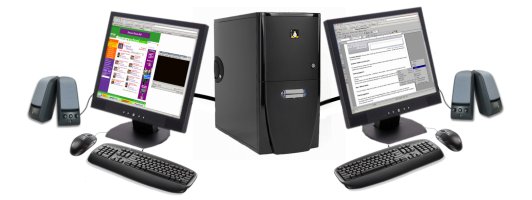SLIM Advantages
Save up to 80% on hardware costs, and up to 90% TCO
Save up to $40/user/year in electricity. (at $0.10/kwh)
Reduce clutter and noise
Instead of maintaining several computers, move all of your files and programs to one powerful machine.
Every member of a family can use the computer at the same time -- no more fighting!
Full 3D video hardware accelleration for each user
Game head to head in games like Quake 4 or Doom 3, or switch to SLI mode for high powered single-user performance.
Implementation is completely Open Source

What exactly does SLIM mean?
In short, you can plug 10 keyboards, 10 mice, 10 monitors, and 10 sets of speakers into one computer. From a user perspective, it works just like you have 10 separate computers. It is:
- Simultaneous: more than one person can use the computer at the same time
- Local: everything is plugged directly into one machine, no network is necessary
- Independent: each user has control of their own monitor, keyboard, mouse, and speakers
- Multi-User: two or more users on one machine
Full Performance
Today's processors are extremely fast, and they sit idle 99% of the time. Running 10 users doesn't require ten times as much memory, because most of the programs running are the same between users and the memory can be shared. Today's hard drives are huge and it is much more economical to buy big hard drives and share them between users. Some intense activities like advanced 3D games may slow other users down slightly, but you can run some 3D games in parallel without noticing you're on a two-user system! Office work, web browsing, and most games don't even come close to using up all the system resources. If you bought two or three separate systems that added up to the price of one Groovix system, all of the components would be older and slower. The Groovix system, even with 2 or 3 simultaneous users, would actually run faster than those separate computers.
A New Approach to a Proven Idea
Non-local (networked) multiple users on one machine has always been a part of Unix computing in the form of dumb terminals and thin clients. Thin clients still require a relatively expensive computer for each user, only giving them a small cost advantage over single-user computers. Thin clients also rely on a server for most processing tasks, making them unsuitable for many desktop computing tasks due to network latency.
The SLIM approach only requires extra video cards, sound cards, keyboards and mice for additional users. Because they are all directly plugged into one box, each user experiences full performance .

